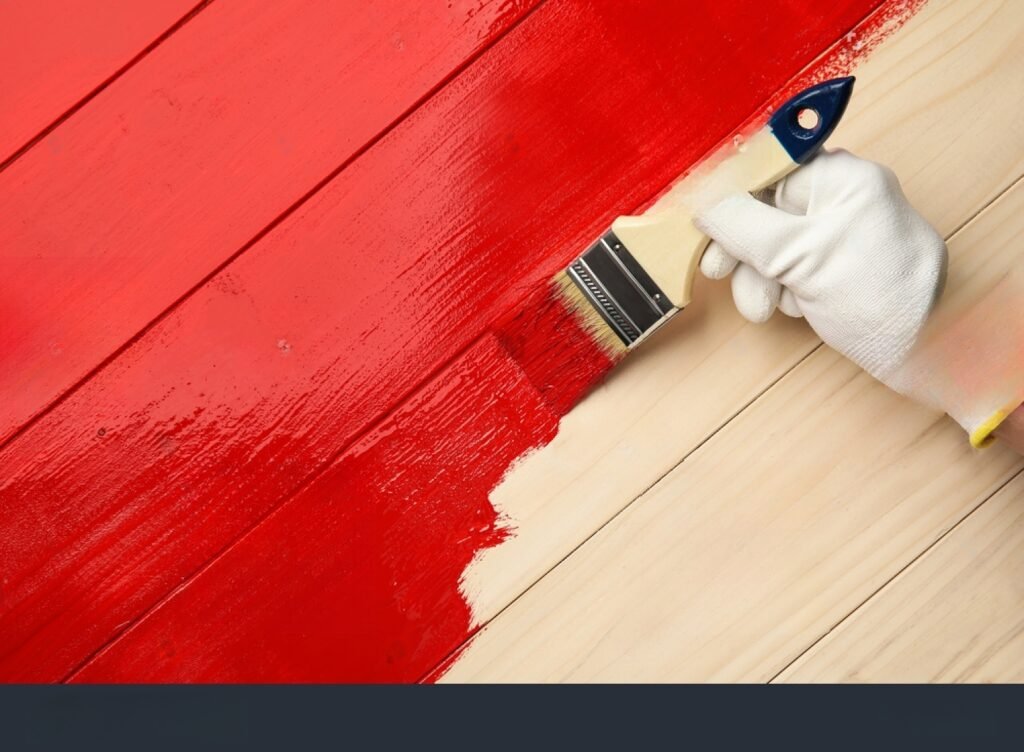Introduction to Latex Paints
Latex paints, commonly known as acrylic paints, have emerged as a popular choice for both residential and commercial applications. Renowned for their versatility and less harmful environmental impact, they stand distinctively apart from oil-based paints. At the core of latex paints lies a water-based formula, which provides numerous benefits, such as quicker drying times and easier clean-up with just soap and water.
The fundamental chemistry of latex paints revolves around micelles suspended in water. These micelles contain minute particles of acrylic resin that form a durable film once the water evaporates. This film offers robust adhesion properties and flexibility, ensuring longevity and resistance to cracking or peeling. Additionally, the absence of heavy solvents in latex paints significantly minimizes the emission of volatile organic compounds (VOCs), contributing to better indoor air quality and a reduced environmental footprint.
Another compelling advantage of latex paints is their adaptability to various surfaces. They are commonly used on interior walls, ceilings, and exteriors of buildings because of their impressive coverage and aesthetic appeal. Whether it’s enhancing the charm of a living room or providing a fresh coat to a commercial space, latex paints ensure a smooth and polished finish.
Moreover, latex paints are easy to work with, making them a preferred choice among DIY enthusiasts and professional painters alike. The rapid drying properties allow for quicker project completion times and minimal downtime. This efficiency proves especially valuable in commercial settings where time constraints are often critical.
In summary, latex paints offer a blend of practicality, environmental advantages, and high performance, setting them apart as a go-to option for a myriad of painting projects. Their water-based nature, combined with advanced chemical formulation, underscores their superiority and enduring popularity. As we delve deeper into their features and applications, the integral role of latex paints in modern-day painting becomes increasingly evident.
Types of Latex Paints
Latex paints come in a variety of formulations tailored for specific applications, making it imperative to choose the right type to achieve the desired outcome. Understanding the characteristics and ideal use cases of each type can ensure your project’s success.
Interior Latex Paints
Interior latex paints are designed for indoor applications, offering a durable and easy-to-clean finish that can withstand moderate wear and tear. This type of paint typically provides low levels of volatile organic compounds (VOCs), ensuring minimal odor and reduced environmental impact. Interior latex paints are formulated to be splatter-resistant and quick-drying, making them suitable for rooms frequently in use, such as living rooms, bedrooms, and kitchens.

Exterior Latex Paints
Designed to withstand harsh outdoor conditions, exterior latex paints contain additives that enhance their durability against ultraviolet (UV) radiation, moisture, and temperature fluctuations. These paints offer superior adhesion to a variety of surfaces, including wood, vinyl, and masonry, making them ideal for painting exterior walls, fences, and outdoor furniture. Additionally, some formulations contain mildew-resistant properties, providing an extra layer of protection in humid climates.

Specialty Latex Paints
In addition to standard interior and exterior formulations, specialty latex paints are available for more specific needs. Mildew-resistant latex paints are fortified with antimicrobial agents to thwart mold and mildew growth, making them ideal for bathrooms, basements, and other damp areas. For high-traffic spaces, such as hallways and commercial settings, latex paints designed for enhanced durability offer superior resistance to scuffs, stains, and abrasion. These paints are often easier to maintain and clean, ensuring long-lasting aesthetics even under heavy use.
With the diverse selection of latex paints available, choosing the right type involves a careful assessment of the project requirements, environmental conditions, and specific preferences. Whether it’s a cozy interior revamp or a sturdy exterior refresh, understanding the unique properties of each latex paint ensures optimal results and lasting satisfaction.
Advantages of Using Latex Paints
Latex paints have gained immense popularity in both DIY projects and professional applications due to their multitude of benefits. One of the most significant advantages of using latex paints is their quick drying times. Unlike oil-based paints, which can take several hours to dry, latex paints allow for faster project completion, enabling multiple coats to be applied in a single day. This efficiency is particularly beneficial for busy painters and homeowners who are eager to see their projects completed swiftly.
Moreover, latex paints are noted for their ease of cleanup. Because they are water-based, cleaning brushes, rollers, and other painting equipment can be done effortlessly with just soap and water. This user-friendly aspect makes latex paints an appealing choice for DIY enthusiasts who might not have specialized cleaning solvents on hand. The reduction in cleaning time also translates into less hassle and greater convenience.
Health and environmental considerations further elevate latex paints above other types. They contain fewer volatile organic compounds (VOCs), which are chemicals that can easily evaporate and contribute to air pollution and potential health issues. Lower levels of VOCs mean that latex paints are not only safer for users but also more environmentally friendly, making them a responsible choice for those cognizant of their ecological footprint.
In addition to these practical benefits, latex paints provide superior flexibility and durability. Over time, surfaces painted with latex are less prone to cracking and peeling compared to their oil-based counterparts. This resilience ensures a longer lifespan for paint jobs, reducing the need for frequent touch-ups and repairs. For both professional painters and DIY hobbyists, this durability translates into cost savings and sustained aesthetic appeal.
These aforementioned attributes make latex paints highly versatile and advantageous, catering to a broad spectrum of painting needs. From ease of application to long-term durability, latex paints stand out as a practical and efficient option, ensuring high-quality results for any project.
Preparing Surfaces for Latex Paint Application
Properly preparing surfaces is a crucial step in ensuring the success of any painting project with latex paints. The preparation process involves cleaning, sanding, and priming, and each step is essential for achieving optimal adhesion and a smooth, long-lasting finish.
Firstly, cleaning the surface is paramount. Begin by removing any dirt, grease, or loose particles using a mild detergent mixed with water. A thorough cleaning ensures that the paint will bond effectively to the surface without interference from contaminants. For surfaces with stubborn stains or mold, a solution of trisodium phosphate (TSP) can be used for a deeper clean.
After cleaning, the next step is sanding. Sanding helps to smooth out imperfections and provides a slightly rough texture that allows latex paint to adhere better. For previously painted surfaces, especially those with oil-based paints, sanding is essential in creating a bondable surface for the new paint layer. Use fine-grit sandpaper to avoid damaging the surface while ensuring adequate roughness for the paint to grip.
Priming the surface is the final preparation step. Primers serve as a base coat that enhances adhesion and provides an even foundation for the latex paint. This step is especially important when painting over darker colors, stains, or transitioning from oil-based paints to latex paints. Select a high-quality primer suitable for the specific surface you are working on—whether it’s drywall, wood, or metal—to prevent any issues with paint adherence and durability.
Dealing with unique challenges such as painting over oil-based paints requires additional care. It’s advised to use a bonding primer specifically designed for these situations to ensure the latex paint adheres appropriately. Moreover, addressing moisture issues is critical. Any signs of moisture or leaks should be repaired before painting to avoid bubbling or peeling paint.
In conclusion, investing time in proper surface preparation significantly contributes to the longevity and aesthetic appeal of latex paint applications. By meticulously cleaning, sanding, and priming, you establish a strong foundation for your paint, ensuring your efforts result in a beautiful and enduring finish.
Techniques for Applying Latex Paints
When it comes to painting with latex paints, achieving a professional finish requires not only the right tools but also mastery of specific techniques. Starting with the tools, essential items include brushes, rollers, and sprayers. Each serves a unique purpose and can significantly influence the outcome of your project.
Brushes: Ideal for intricate details and edges, brushes are perfect for cutting in along ceilings, corners, and trim. Opt for synthetic bristles as they work best with latex paints. A 2- to 3-inch angled brush is optimal for most tasks.
Rollers: For covering large, flat areas like walls and ceilings, rollers are indispensable. Choose a roller cover with a nap suited to the surface you’re painting—short naps for smooth surfaces and longer naps for textured walls.
Sprayers: If you seek an ultra-smooth finish, sprayers can deliver. Suitable for larger exterior surfaces or fine cabinetry, sprayers need a bit of practice. Ensure the paint is properly thinned as per the manufacturer’s instructions to prevent clogs.
Proper mixing of latex paint is critical; stir the paint thoroughly before application to ensure a consistent color and texture. The ideal painting conditions significantly impact the final result—temperatures between 50-85°F and humidity levels below 50% are optimal. If the environment is too cold, the paint might not adhere well, whereas excessive heat can cause premature drying.
Technique plays a crucial role, whether you’re using brushes, rollers, or sprayers. Apply steady, even pressure and overlap each stroke to avoid streaks. Layering multiple coats is often necessary for full coverage and durability; allow adequate drying time between coats, generally 2-4 hours. To tackle common issues like streaks or bubbles, ensure your tools are clean and in good condition, and avoid shaking the paint can as it can introduce air bubbles—stir gently instead.
Incorporating these best practices can significantly enhance the quality of your latex painting project, ensuring a smooth, professional-looking finish that stands the test of time.

Common Problems and How to Avoid Them
When working with latex paints, it is essential to be aware of some common issues that can arise. One of the most frequent problems is peeling. Peeling occurs when the paint does not properly adhere to the surface, and it can be caused by several factors including inadequate surface preparation, application on a dirty or greasy surface, or excessive moisture. To prevent peeling, ensure the surface is clean, dry, and free from all contaminants before beginning the painting process. Using a good quality primer can also significantly improve adhesion.
Another prevalent issue is blistering, which manifests as bubbles or blisters on the painted surface. This problem typically arises when the paint is exposed to high levels of moisture or heat during or after application. Blistering can be mitigated by painting in optimal weather conditions, avoiding high humidity and extremely high temperatures. In addition, it is crucial to allow each layer of latex paint to dry completely before applying subsequent coats. Proper ventilation can also help in reducing the risk of blistering.
Uneven coverage is a common concern when using latex paints, often resulting in a patchy or streaky finish. This issue can be caused by inadequate mixing of the paint, subpar tools, or insufficient paint application. To achieve an even coat, ensure the paint is thoroughly mixed before use. Utilize high-quality brushes or rollers for application, and do not attempt to stretch the paint too thin; it is better to apply multiple thin coats rather than a single, thick one. Feathering the edges of each stroke can also help in blending brush marks and achieving uniform coverage.
To troubleshoot these problems effectively, always refer to the manufacturer’s recommendations and guidelines. Routine maintenance such as inspecting the painted surfaces periodically and performing touch-ups as needed can also sustain the integrity of your latex paint projects. Adopting these preventive measures and troubleshooting strategies will ensure that your painting endeavors yield a high-quality end result.
Maintenance and Longevity of Latex Painted Surfaces
Proper maintenance is crucial to ensure that surfaces painted with latex paint retain their appearance and durability over time. Regular cleaning of these surfaces can significantly extend the paint’s lifespan. For routine cleaning, use a mild detergent mixed with water and a soft cloth or sponge to gently wipe down the painted area, avoiding abrasive materials that could damage the finish.
Touch-ups are an inevitable part of maintaining the pristine look of latex-painted surfaces. To achieve seamless results, it is advisable to keep a small amount of the original paint for this purpose. When the surface shows minor imperfections or chips, clean the area thoroughly, lightly sand the edges, and apply the matching latex paint. This approach ensures consistency in color and texture.
When addressing more significant wear and tear, consider the underlying causes, such as exposure to moisture, harsh chemicals, or direct sunlight. Environmental factors play a substantial role in the longevity of latex paints; for instance, high humidity can lead to peeling, while prolonged sun exposure can cause fading. To mitigate these effects, consider proactive measures such as applying a clear protective sealant to exterior surfaces or using UV-resistant formulations for areas with extensive sun exposure.
Additionally, maintaining a stable indoor environment with controlled humidity levels and good ventilation can further preserve latex-painted surfaces. In locations prone to excessive moisture, such as kitchens and bathrooms, ensure proper ventilation and consider using mildew-resistant latex paints to prevent mold growth and maintain the durability of the finish.
By incorporating these maintenance practices, homeowners can maximize the longevity and aesthetic appeal of their latex-painted surfaces. Regular cleaning, prompt touch-ups, and environmental considerations are essential to maintaining the vibrant look and structural integrity of latex paint over time.
When working with latex paints, safety considerations are paramount to ensure both user health and environmental protection. Proper ventilation is essential; always paint in well-ventilated areas to avoid inhaling fumes, even though latex paints generally emit lower levels of volatile organic compounds (VOCs) compared to other paint types. Utilizing protective gear such as gloves, goggles, and masks can prevent skin contact and inhalation of paint particles, further reducing potential health risks.
Storage of latex paints also requires careful attention. Store paints in cool, dry places, and ensure containers are sealed tightly to prevent spillage and evaporation. Always keep paint cans away from extreme temperatures to maintain their usability and prevent hazardous incidents. Proper labeling of the containers can help in identifying the contents and avoiding accidental misuse.
Environmental impacts of latex paints largely pivot on their composition. Opting for low-VOC products significantly reduces the release of harmful chemicals into the atmosphere. These eco-friendly formulations not only benefit personal health but also contribute to lower environmental pollution. When purchasing paint, seek out brands that prioritize sustainable practices and transparency about their ingredients.
Disposing of leftover latex paint demands responsible practices to mitigate environmental harm. Unused paint should never be poured down the drain or disposed of in regular trash. Instead, consider these eco-friendly methods: donate surplus paint to community projects or institutions, repurpose it for small household tasks, or recycle it at local hazardous waste disposal programs or paint recycling centers.
By integrating these safety and environmental practices, individuals can significantly minimize their ecological footprint. Choosing latex paints with minimal environmental impact and practicing responsible disposal not only ensures personal safety but also contributes to broader environmental sustainability. Embracing these principles aligns with the ongoing global efforts to create greener, healthier living spaces for everyone.

